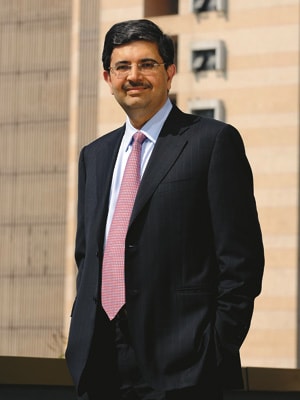
Uday Kotak: Banking At High Velocity
Uday Kotak’s astuteness has put him in the exclusive club of billionaires, and increased Kotak Mahindra Bank’s market cap
Uday Kotak
Age: 52
Profile: Founder of Kotak Mahindra Bank and India’s first billionaire banker.
Rich List Rank: 15
Wealth: $3.6 billion
His Strength:
Building a team that enjoys what it does.
During every crisis, the entire top team would huddle together like a cricket team
To see how far Uday Kotak has come, you don’t have to go to his office at Nariman Point, Mumbai. Go instead to the eastern sliver of central Mumbai called Cotton Green. More than 150 years ago, it was home to the first cotton exchange in India. Cotton trade was where Uday Kotak’s family made its initial mark and money. But when he turned entrepreneur in 1985, the Indian textile sector was in a shambles. A young Uday moved into financial services and has now taken Kotak Mahindra Bank (KMB) to a market capitalisation of Rs. 34,655 crore.
Today, Kotak’s personal worth stands at $3.6 billion and he is the first billionaire from the banking sector in India. In a highly regulated sector like banking, it is a measure of Kotak’s entrepreneurship that he has managed to create so much value in such a short period.
The key to Kotak’s tremendous rise is a subversion of the old capitalist theme: Win-lose. Kotak’s speciality is creating win-win situations. He began his journey with one such decision. When he brought on father-son duo Harish and Anand Mahindra as investors in his company he was acknowledging that credibility is the life-blood of a financial services player. “Nobody knew who Kotak was,” he said explaining that decision. It would have been easy to try and go it alone like many finance entrepreneurs in the early days of post-reform India. Very few made it big. Kotak was happy to align with various partners, be it Ford Credit for auto-finance, Goldman Sachs for investment banking or Old Mutual for life insurance.
Anand Mahindra knew Kotak was special the first time he met him. Mahindra was at the helm of Mahindra Ugine Steel Company in those days. Kotak turned up with a bill discounting proposal. “I asked him ‘[when] the steel sector is in a tailspin, why do you want to put money in our company?’ And he said he believed that Mahindra Ugine would be able to come out of it stronger. He took the long view,” says Mahindra, vice chairman and managing director, Mahindra & Mahindra.
Kotak has been gifted with a mind that is opportunistic and conservative. His senior team knows that not being in a happening sector is not an option. Hence, KMB is present in almost all financial services segments, like banking, fund management and insurance. “Uday focusses on real returns. He doesn’t look at market capitalisation increase alone,” says Sanjeev Prasad, executive director, Kotak Securities. In an interview to the Boston Consulting Group’s Janmejaya Sinha, Kotak has said: “The ability to seize opportunity is critical… but there’s a thin line between conviction and foolhardiness.”
A slowdown teaches one the value of having cash as a cushion. Fortunately for Kotak, his first brush with recession happened in 1996-1998. “I think he always keeps that scenario in mind when he invests,” says Asim Ghosh, an independent director on KMB’s board. One of the ways in which Kotak achieves this is by limiting the size of the initial bet.
Kotak has built his team assiduously over the years. Most of his senior team members have been with the group for more than 15 years. A lot of it has to do with the fact that Kotak is genuinely a warm human being. “He is able to generate that air of camaraderie. I remember in the early days I used to find him with his team discussing things at what was then Rangoli restaurant at the National Centre for the Performing Arts [in Mumbai],” says Mahindra. Kotak has said in the past that throughout the 1990s, during every crisis, the entire top team would huddle together like a cricket team.
Kotak’s focus on nurturing talent was clear: Give people elbow room to create their own destiny, but convey to them that it has to be done ethically. It has not been about simply handing out fat cheques. “In any case, money has never been an adequate compensation for unhappiness. And when you see Uday’s team, you know they enjoy what they do,” says Mahindra.
This facet of Kotak has helped the bank compete well with the other strong banking startup, Yes Bank.
Even if the banks are comparable based on their income levels at Rs. 4,000 crore, KMB has a market capitalisation that is 3.5 times higher than Yes Bank’s.
KMB was heavily dependent on the investment banking business in 2007 and 2008. In 2011, this number dropped to 11 percent. Today, almost 60 percent of the bank’s loans are related to housing and the auto sector. A Bank of America Merrill report states that “KMB, to its credit, has managed to create a loan profile that is much better than most peers.”
The bank is proof of the legacy that Kotak has built: Solid, opportunistic and performance-oriented. And in the process, it has created a lot of wealth for its founders and shareholders.
(This story appears in the 30 November, -0001 issue of Forbes India. To visit our Archives, click here.)





